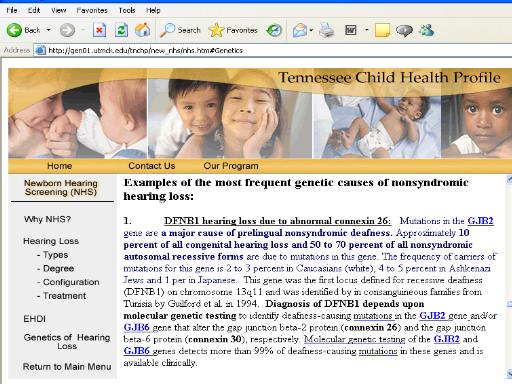Tennessee Child Health Profile Examples of the most frequent genetic causes of nonsyndromic hearing loss:

Screen shot of the middle section of the Newborn Hearing Screening (NHS) Web page entitled "Examples of the most frequent genetic causes of nonsyndromic hearing loss:
1. DFNB1 hearing loss due to abnormal connexin 26: Mutations in the GJB2 gene are a major cause of prelingual nonsyndromic deafness. Approximately 10 percent of all congenital hearing loss and 50 to 70 percent of all nonsyndromic autosomal recessive forms are due to mutations in this gene. The frequency of carriers of mutations for this gene is 2 to 3 percent in Caucasians (white), 4 to 5 percent in Ashkenazi Jews and 1 per in Japanese. This gene was the first locus defined for recessive deafness (DFNB1) on chromosome 13q11 and was identified by in consanguineous families from Tunisia by Guilford et al. in 1994. Diagnosis of DFNB1 depends on molecular genetic testing to identify deafness-causing mutations in the GJB2 gene and/or GBJ6 gene that alter the gap junction beta-2 protein (connexin 26) and the gap junction beta-6 protein (connexin 30) respectively. Molecular genetic testing of the GJB2 and GJB6 genes detects more than 99% of deafness-causing mutations in these genes and is available clinically.
 Previous Slide Contents Next Slide
Previous Slide Contents Next Slide 

